In this article
View 5 More +Ear cancer is a relatively common occurrence in cats. Two main types of tumors affect a cat’s ears. These are ear canal tumors and skin cancer tumors. Ear canal tumors are usually found in the outer area of the ear and the external ear canal. They can also be seen in the inner or middle ear, but they are much rarer in this location. Skin cancer tumors are called squamous cell carcinomas. They are found on and around the pinna of the ears.
Ear cancers in cats can cause considerable discomfort and pain and some have the ability to spread to other parts of the body and can have devastating effects. Early diagnosis and initiation of treatment are vital for a good prognosis.

What is Ear Cancer in Cats?
Ear cancer can present as ear canal tumors or skin tumors.
Ear canal tumors can be benign or malignant. Malignant tumors have the potential to spread to other areas in the body, while benign tumors do not spread. The tumors are groups of abnormally growing cells that originate from a specific part of the ear.
- Skin
- Glands of the skin
- Connective tissues
- Bones
- Muscles
Ear canal tumors are more commonly found in the external ear canal as opposed to the inner or middle ear. Commonly seen external ear canal tumors include:
- Adenocarcinomas
- Ceruminous gland adenomas
- Inflammatory polyps
- Sebaceous gland adenomas
- Squamous cell carcinomas
- Papillomas
Skin tumors on a cat’s ears are usually squamous cell carcinomas. Squamous cell carcinoma is an invasive and malignant tumor that occurs in one of the layers of the skin. Very often these sorts of tumors are seen in cats with white or pale coats that spend a lot of time in the sun. The tumor starts as a red scabby patch, normally on the tips of the ears. The skin can become ulcerated and infected and gradually increase in size.
The prognosis can be very good if identified and treated early but if left untreated, due to it being a highly malignant tumor, the prognosis can be grave.
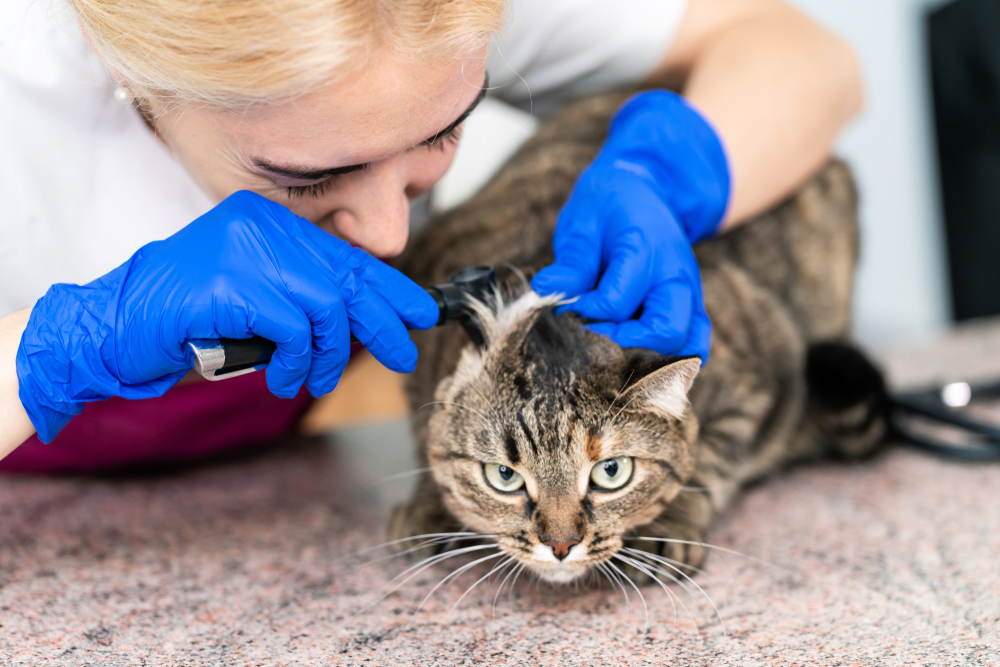

What Are the Signs of Ear Cancer in Cats?
Signs your dog may have ear canal tumors include a mass present—the mass may vary in size and color. Benign masses may stay small and cause no damage to the surrounding tissues. Malignant masses can grow rapidly, bleed, and become ulcerated. They often become infected. Both types of masses can grow to completely occlude the ear canal. It may or may not be possible to visibly see the mass depending on the location.
- Redness of ears
- Scratching of ears and surrounding area
- Pain when touching ears
- Foul-smelling discharge including wax, pus, and blood
- Head shaking
- Aural hematoma (blood clot between ear cartilage)
- Head tilt
- Circling
- Nystagmus (eye flickering)
- Loss of balance
- Loss of hearing
- Horner’s syndrome (a condition that affects nerves in the face)
The signs on the second half of the list above are usually seen if there is a tumor present in the middle or inner ear.
Signs of skin tumors on a cat’s ears can start off looking like a cut or a graze or a wound from a fight. Early detection and initialization of treatment are crucial for a good prognosis. Therefore, it is important that if you see any lesions on your cat’s ears, to get an appointment with your vet as soon as possible.
Signs of skin tumors on cat’s ears are usually found on the tips of their ears and include:
- Redness on tips of ears
- Raised areas
- Hair loss
- Scabs/crusty sores
- Ulcers that often bleed
- Skin infection
- Foul odor
- Malformation of the ear
- Deformities of the ear
- Lesions may spread to the face and surrounding areas
If your pet is showing these signs, we suggest you speak to a vet.
If you need to speak with a vet but can't get to one, head over to PangoVet. It's an online service where you can talk to a vet online and get the advice you need for your pet — all at an affordable price!


What Are the Causes of Ear Cancer in Cats?
There are many different causes of ear canal tumors. Usually, it is a combination of different risk factors. Lots of these are genetic and a predisposition can be inherited. Some will be environmental and related to the cat’s diet or lifestyle. There is currently no genetic component identified that directly causes ear canal tumors, however, factors such as chronic inflammation in the ears can contribute. This is thought to be because when the ear canal is inflamed, ear wax glands produce thicker secretions which may stimulate cancerous cells to be produced. As well as this, chronic inflammatory changes can lead to hyperplasia, which progresses to dysplasia, finally ending in neoplasia.
Some breeds seem to experience ear canal tumors more frequently than others and this may be because they are genetically predisposed to certain conditions in the ear canal such as inflammation of the ear canal and ear infections. Cats that suffer from repeated ear infections with bacteria, yeast, or mites do seem to be more prone to developing ear tumors.
The causes of ear skin cancer in cats are a little more straightforward. Usually, excessive exposure to sunlight is the cause. White cats or cats of a lighter color are at higher risk. As are cats with thin coats or alopecia (fur loss) on their ears. Hairless cats such as Sphynx cats are also at an increased risk. Cats that overgroom or lick excessively are thought to be at higher risk too as the skin is damaged.
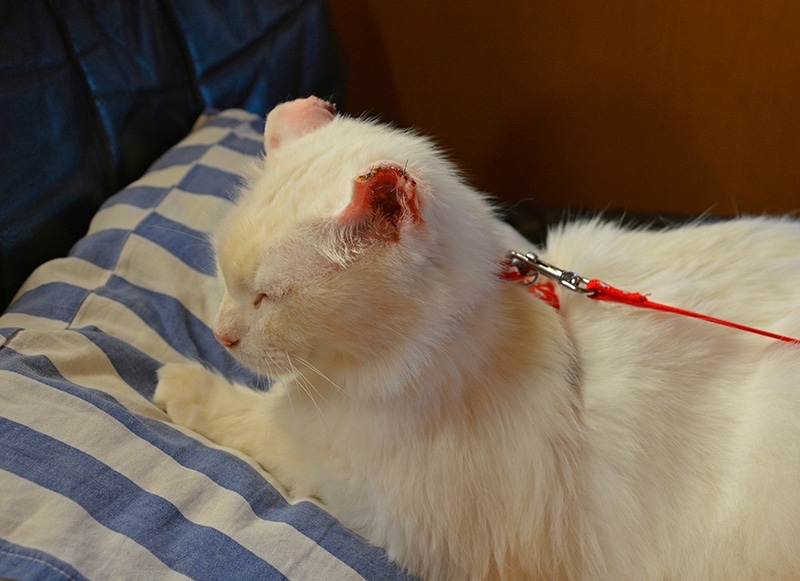

Diagnosis of Ear Cancer in Cats
Ear canal tumors can be difficult to diagnose depending on their location. Other factors such as the state of the lining of the ear canal also affect diagnosis. For example, if there is severe inflammation or infection present, this could potentially obscure the view or cover the tumor.
When a mass has been identified, if it is accessible and safe to do so, your vet will attempt to take a sample. This is done either by a fine needle aspiration biopsy, (which involves taking a sample using a needle and syringe) or by tissue biopsy which involves surgically removing a larger section of the mass. This is all a lot harder if the tumor is deep in the ear canal.
If the tumor is deemed to be malignant, further imaging is usually carried out. This can be X-rays, ultrasounds, CTs, or MRIs. The results from the imaging will be used to assess how locally invasive the tumor is and also to assess if there is any evidence of spread around the body. This is called staging of the tumor. This then enables your vet to plan surgery if appropriate.
Ear skin cancer is diagnosed based on clinical history, clinical signs, and samples taken from lesions present. Usually, there will be sores or ulcerative lesions that can be sampled. This is done using fine needle biopsy or full tissue biopsy. Ultrasound of local lymph nodes may be carried out and X-rays taken of the chest to confirm if metastatic disease is present. It is less common to use CT or MRI to diagnose skin ear tumors.
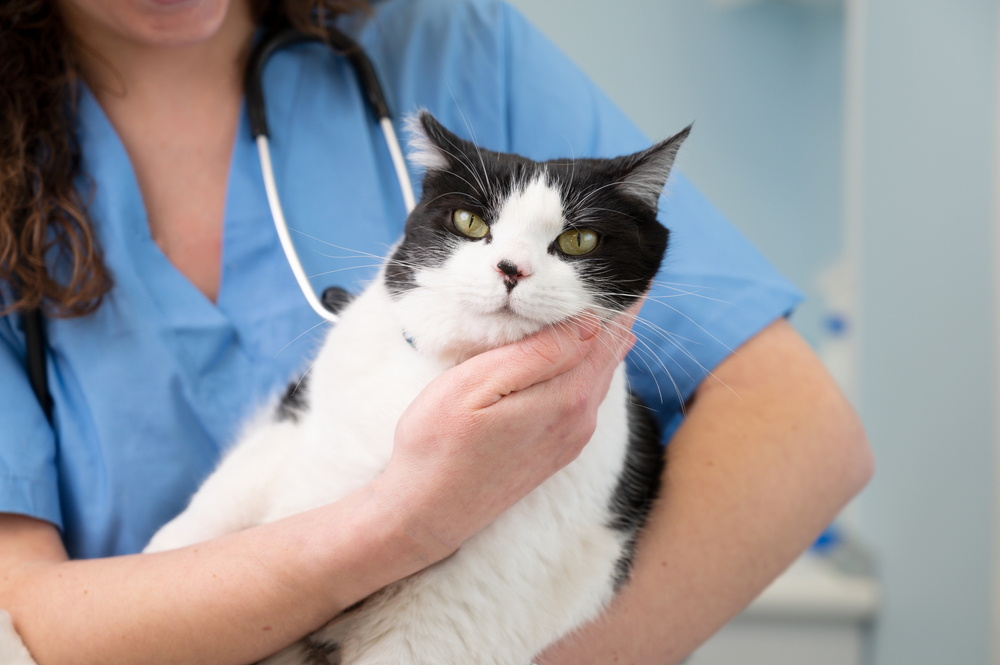
How Do I Care for a Cat with Ear Cancer?
Treatment for ear canal tumors largely involves surgical excision. If the tumor is benign and all of it is removed, the prognosis is good. If the tumor is malignant, it can be more challenging as the tumor is capable of infiltrating many different areas and layers of tissue. One option is to perform a total ear canal ablation and bulla osteotomy. This means all of the outer and inner ear canal and the tympanic bulla are removed completely. For some tumors, it is not possible to remove all of them with clean margins. In these cases, radiotherapy is an option. For larger inoperable tumors, this can be used to stunt the growth and potentially offer some pain relief.
Treatment for skin ear tumors largely depends on how severe the lesions are and if they have spread to other parts of the body. Once identified, some small lesions can be removed by cryosurgery, which is the process of freezing. The other option is to surgically remove them. Due to the aggressive nature of the tumors, often parts of the pinnae and the ear canal are removed too. This is to ensure that all of the lesion is removed. Despite this, squamous cell carcinomas do often reappear at the same site. Careful surveillance of the area must be carried out post-operation.
Most cats recover well from the surgery and adjust very quickly. If your cat is not a good candidate for surgery, the third option is chemotherapy. This is not usually as effective as surgical removal and is done by a specialist oncologist.


Frequently Asked Questions
How long will a cat live with ear cancer?
The life expectancy of a cat with ear cancer will largely depend on the severity of the clinical signs, the tumor type, and the treatment options available. In one study, the median survival time of cats treated with surgery was 168 days vs 85 days for those treated palliatively.
Cats that have neurological signs have a poorer prognosis. Cats showing evidence of metastatic disease have a poorer prognosis again.
How do I know if my cat has ear cancer?
It can be difficult to spot if your cat has ear cancer, depending on the location and severity of the cancer present. Common signs owners notice at home include scabs or ulceration on the skin, redness of the ears, painful ears when touched, foul-smelling discharge (blood, pus, or excess wax from ears), head shaking, scratching ears, and neurological signs.
Are cat ear tumors painful?
Ear tumors in cats can be very painful. Common clinical signs include inflammation and itching both of which can cause pain, especially if the cat is scratching until they do themselves damage. If the tumor is taking up a large space and pressing on other structures this can also cause immense pain.
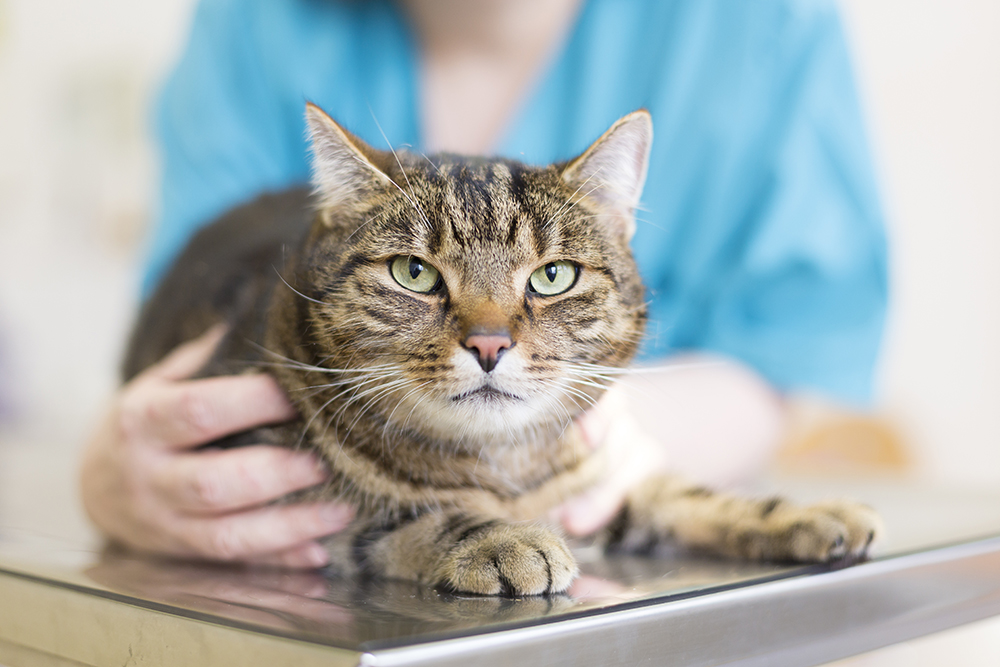

Conclusion
Ear cancer in cats is a common issue seen in clinical practice. It can affect the external ear canal, the middle and inner ear, and the pinnae of the ear. The tumors can be benign or malignant.
One of the most common in the ear canal is the ceruminous gland adenocarcinoma, while squamous cell carcinoma is most common on the pinnae. Early diagnosis and prompt treatment are paramount in the successful resolution and prognosis.
Featured Image Credit: RJ22, Shutterstock
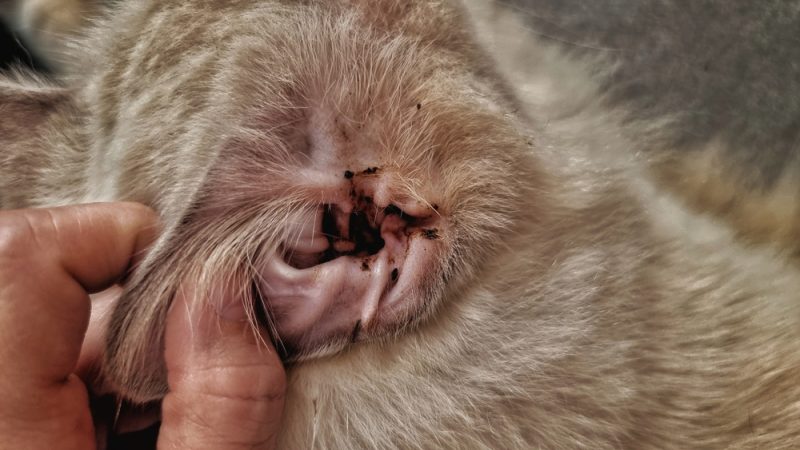

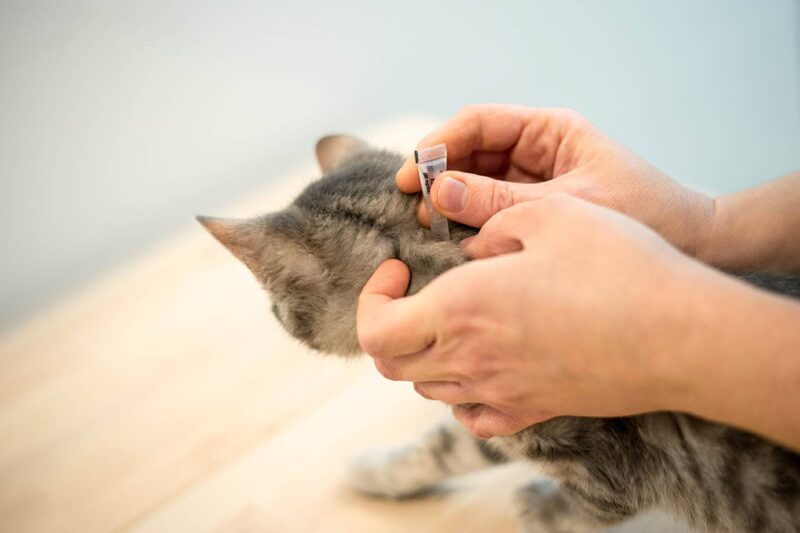
















2 Responses
I have been taking care of a stray cat with what appears to be squamous cell carcinoma in/on the ears. It is very advanced. In my estimation, palliative care is the only option. Truthfully, I don’t know exactly what that means for animals. I’m a retired hospice worker, so I do know what it means for humans. Can you give me any info/advice on possible treatments? I can’t imagine the cat is not in pain but she’s friendly and still has a good appetite. Sincerely, a concerned animal lover.
Hi from Catster's customer service, Niko.
We understand your deep concern for this stray cat and your thoughtful approach, especially with your background in hospice work. It takes a compassionate heart to care for an animal in this situation.
We must remind you that our author veterinarians do not manage the comments section. And, through this channel, we cannot give you any specific medical advice on treatments or pain management for a complex condition like advanced squamous cell carcinoma.
For a severe and advanced condition, you are absolutely right to focus on comfort and quality of life. For animals, "palliative care" means maximizing comfort and minimizing pain, exactly as it does for humans.
Given your concern about pain, it is vital to have the cat evaluated by a veterinarian who can create a medical plan tailored for comfort and quality of life.
You may find this article helpful for general information:
Palliative Care for Cats
https://www.catster.com/lifestyle/palliative-care-for-cats/